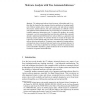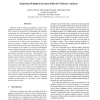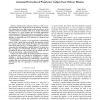95 search results - page 2 / 19 » The Software Similarity Problem in Malware Analysis |
CAV
2011
Springer
12 years 9 months ago
2011
Springer
Abstract. The underground malware-based economy is flourishing and it is evident that the classical ad-hoc signature detection methods are becoming insufficient. Malware authors ...
NDSS
2009
IEEE
14 years 1 days ago
2009
IEEE
Anti-malware companies receive thousands of malware samples every day. To process this large quantity, a number of automated analysis tools were developed. These tools execute a m...
SP
2007
IEEE
13 years 11 months ago
2007
IEEE
Malicious code (or malware) is defined as software that fulfills the deliberately harmful intent of an attacker. Malware analysis is the process of determining the behavior and ...
ESORICS
2011
Springer
12 years 5 months ago
2011
Springer
Program authorship attribution—identifying a programmer based on stylistic characteristics of code—has practical implications for detecting software theft, digital forensics, a...
SP
2010
IEEE
13 years 9 months ago
2010
IEEE
Abstract—Unfortunately, malicious software is still an unsolved problem and a major threat on the Internet. An important component in the fight against malicious software is the...



